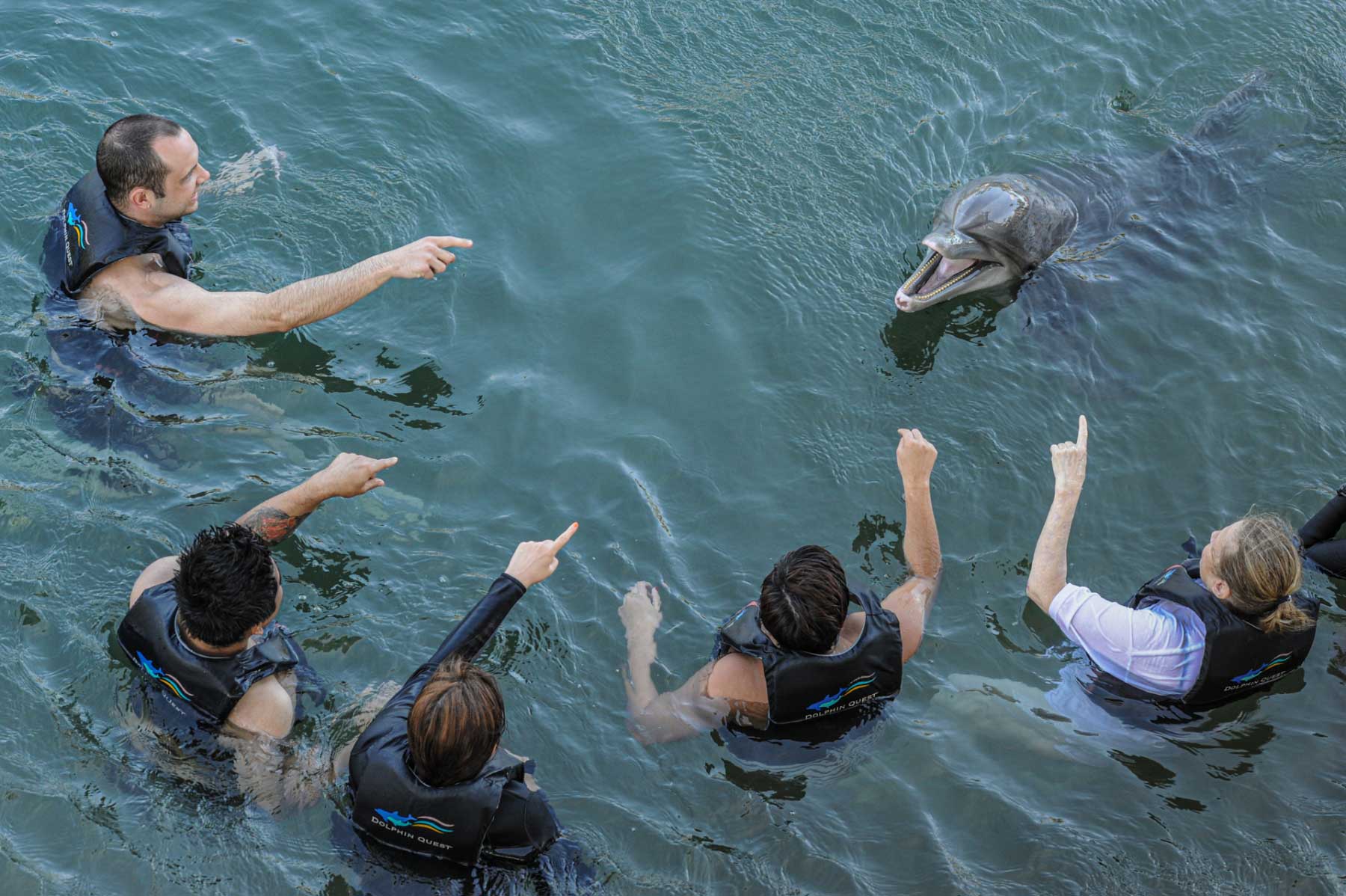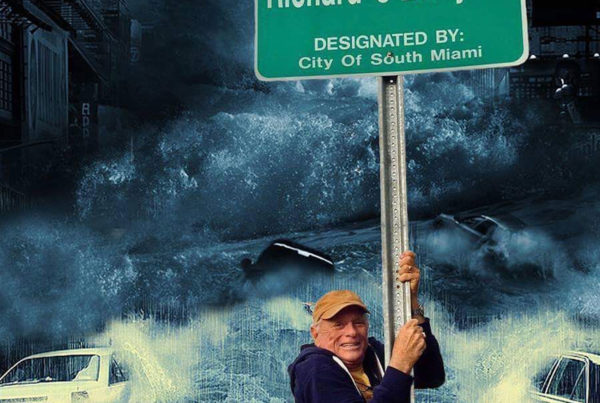Whales and dolphins are highly intelligent creatures who want and need to live in complex social groups, and can swim up to 100 miles a day, hunting and playing. In captivity, they have very little space and cannot behave naturally. A concrete tank can never replace their ocean home.
WHY IS IT NOT A GOOD IDEA TO KEEP DOLPHINS IN CAPTIVITY?
Dolphins are highly intelligent animals. In the wild, they live in complex social groups. In captivity, dolphins live shorter lives than they do in the wild. This is significant given the fact that they are kept in an environment that is free of predators, pollution and other threats that they face in the wild. Wild dolphins can swim up to 100 miles a day but in captivity, they have very little space in which to move around and so display unnatural behaviour. The captive environment can never replace their natural one.
IS IT POSSIBLE TO SUCCESSFULLY RETURN DOLPHINS TO THE WILD?
All dolphins should be given the chance to show that they can re-learn the skills that would help them survive in the wild but in some cases, this might not be possible. We would still like to see these dolphins taken out of concrete tanks, and show pools and instead put in a retirement programme in a more natural environment where they no longer have to perform tricks in shows.
HOW BIG WOULD AN APPROPRIATE TANK HAVE TO BE FOR KEEPING DOLPHINS IN CAPTIVITY?
No tank can be big enough as they can swim up to 100 miles a day and it is also impossible to replicate their natural environment in captivity.
IS CHLORINE IN THE TANK WATER GOOD FOR DOLPHIN HEALTH?
While chlorine may help keep tank water looking clean, it may present a problem to dolphin health.
DO ORCAS AND DOLPHINS LIKE TO PLAY WITH BALLS OR HOOPS?
Whales and dolphins have been trained to perform these tricks. While they may relieve some of the boredom of being held captive, they would no doubt be happier if they could carry out more natural behaviour. During the show, dolphins are fed after every trick as a reward. They may perform simply for the reward of a fish.
DOLPHINS SMILE DURING THE SHOWS SO THEY MUST BE ENJOYING THEMSELVES.
Dolphins cannot move their facial muscles to communicate their inner feelings like humans so dolphins appear to ‘smile’ even when injured or ill.
HOW OFTEN DO THE DOLPHINS HAVE TO PERFORM?
Shows can take place several times a day but dolphins may not be able to rest when they are not performing. They are also involved in training sessions and health checks.
IS IT ETHICAL TO STUDY DOLPHINS IN CAPTIVITY?
The behaviour of orcas and dolphins is constricted by life in a tank. Whales and dolphins are ordinarily intelligent, social animals that live in groups in the wild and carry out a myriad of tasks throughout daily life that are simply impossible in captivity. Most of the knowledge gained from carrying out research in the captive environment may not apply to the conservation of these animals in the wild.
HOW DO DOLPHINARIUMS THREATEN DOLPHINS IN THE WILD?
Wild capture of dolphins is a brutal experience as entire pods are targeted and only the young and fit are removed. Future generations are taken from vulnerable wild populations which are already under threat from human activities and have a hugely negative impact on group dynamics. Methods used to capture and transport dolphins can be shockingly cruel and many animals die during capture operations or in transit.
WHAT HAPPENS TO THE DOLPHINS WHEN THEY ARE NOT TAKING PART IN THE SHOWS?
They are often kept in holding tanks which are smaller than show pools. Confining dolphins together that may not get on with one another can result in stress and aggression from which they can’t escape.
DOLPHINS EAT FRESH FISH IN THE WILD BUT IN CAPTIVITY THEY HAVE TO EAT FROZEN FISH. DOES THAT AFFECT THE DOLPHIN’S HEALTH?
Dolphins are predators of fish and spend up to half of their time in the wild hunting. In captivity, they can not demonstrate this natural behaviour. Frozen fish is also supplemented with vitamins, minerals and even water, suggesting its nutritional value may be lower.
IS IT A GOOD IDEA TO PUT DIFFERENT SPECIES OF DOLPHINS IN THE SAME TANKS?
Captive dolphins in a facility often come from different regions and populations. Dolphins in captivity are often forced to live with other species that may have trouble communicating with one another and may not get on with one another, including species that would never meet in the wild.
WHERE DO THE DOLPHINS AND ORCAS THAT ARE HELD IN EUROPEAN AQUARIUMS ORIGINATE FROM?
From many sources – some from the wild, some bred in captivity while others are moved between parks. For example, the orcas in Loro Parque in Tenerife are on loan from SeaWorld in the US. No institution within Europe provides transparent access to information documenting the shipments of dolphins between European facilities, so information is hard to obtain.
SWIMMING WITH DOLPHINS
Swimming with dolphins, whether with wild individuals or those in captivity, is increasing in popularity. Unfortunately, most participants in these activities are unaware of the problems surrounding them, and the negative impact on the animals involved.
Dolphinarium companies rely on misinforming the public about the true state of affairs in captivity. Tourists have no idea the dolphins they are swimming with are anxious, depressed, heartbroken and sometimes neurotic.
Dolphins pull tourists with their fins or push them out of the water with their faces. The tricks are completely unnatural and interaction of this kind would never occur in the wild. They have to perform the same trick from 10–60 times a day every day of the year.
Dolphins are trained to carry out these tricks by a reward-based system and are fed a fish every time they successfully perform a trick. This means to ensure the dolphins will perform they must be kept hungry. They are fed an adequate amount of food throughout the day but the food is staggered so the dolphins are desperate enough to perform. Staff will tell tourists the dolphins carry out the tricks voluntarily but really they are just obeying an order so they can eat.
Dolphins have been scientifically proven to have extremely sensitive hearing. No dolphinaria park takes this into consideration and dolphins are exposed to extremely loud noises from morning till evening.
Visiting a swim-with-dolphins facility
Swimming with captive dolphins may seem like fun. But the harsh reality is kept hidden. Many people don’t realise that the animals are suffering an impoverished and often dramatically shortened existence in captivity. These intelligent, social and wide-ranging animals are forced to live in artificial, confined conditions, away from their natural family groups. They are unable to communicate, hunt, roam, mate and play as they would in the wild. The stress of their confinement often results in behavioural abnormalities, illness, lowered resistance to disease and death. Many die very young, during capture, transport or in their tanks or enclosures.
In captivity, dolphins cannot escape from human swimmers when they do not want to interact with them
Some have been observed demonstrating signs of alarm when they were in close proximity to swimmers. Nails and jewellery can damage the dolphins’ delicate skin. Dolphins are wild animals and unpredictable, even when well trained. Swimmers have been known to incur bites, bruises, scratches, abrasions and broken bones.
Many facilities keep the dolphins in enclosures on the coast.
Hurricanes have had serious consequences for dolphins in sea pens. Some have been battered by falling debris, washed out to sea and even killed. Water quality can also be a problem. Sea pens close to shore may contain only very shallow water, which can get too hot in the sun, those close to towns or resorts may also contain high pollution levels.
Exposure and pollution
Disease transmission is a serious concern, as dolphins carry diseases that can be transmitted to humans. Dolphins are large, strong animals and entering the water with them can be frightening for swimmers. Many people report a feeling of disappointment as the experience is far from the natural wildlife encounter they were looking for.
Swimming with wild whales or dolphins?
It is very difficult to ensure that it is not an intrusive or stressful experience for the whales or dolphins targeted by swim activities. In some locations, dolphins are repeatedly disturbed by boats dropping swimmers in the water next to them. Dolphins have been recorded leaving their usual homes in favour of quieter areas. Disruption to feeding, resting, nursing and other behaviour may have a long-term impact on the health and wellbeing of individual dolphins and populations.
Other concerns include:
Safety of dolphins and swimmers.
Injury to dolphins by boat propellers.
Risk of dolphins becoming dependent on humans for food, as some boat operators entice them towards the swimmers using food.
Ref: WDC / Header: We Animals Media




